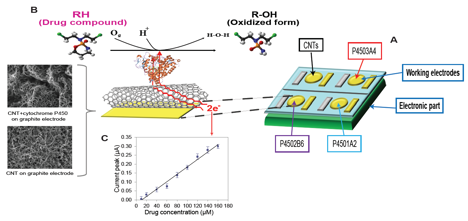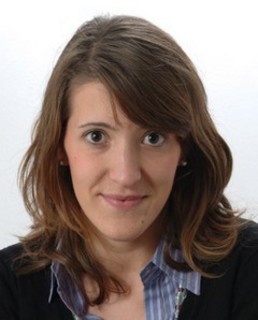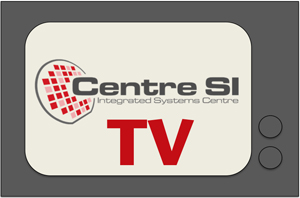Go to
Camilla Baj-Rossi
PhD Student, Integrated Systems Laboratory, Swiss Federal Institute of Technology, Lausanne, Switzerland
P450 Based Nano-chip Platform for Diagnostic Applications in Personalized Therapy
Drug metabolism is hardly predictable since is dependent on many factors, such as patient’s genotype, environmental conditions and patient’s state, or the presence of other drugs within the same therapy. Moreover, several pharmacological treatments for major diseases, such as cancer or HIV, are often based on cocktails of different drugs. For these reasons, in order to individually optimize an ongoing drug therapy, it is required to know drug concentrations as due to the real and effective patient’s metabolism at the moment of the pharmacological cure. The rising demand for the development of personalized therapy recently stimulates significant research in studying feasible electrochemical biosensors based on cytochrome P450 (CYP) for detection of drugs and other chemical compounds1. The detection mechanism is based on the quantification of the drug concentration present in the sample through the coupling of the binding reaction between the CYP and the drug to a current signal, which is detectable with an electrode (the detection mechanism for CYP-based biosensors is schematized in Figure 1. Carbon nanotubes are used for nano-structuring the electrodes in order to decrease the detection limit until the pharmacological ranges of the considered drug compounds, since it has been demonstrated2 that such nanostructures, thanks to their electrical and electrochemical properties, improve the CYP-biosensors selectivity and sensitivity.

Figure 1. (A) P450-based chip platform with four electrodes. (B) On the working electrode surface a cytochrome P450 transforms the redox form of a drug in its oxidized form by using one oxygen molecule and two electrons. (C) In voltammetric measurements, the two electrons are supplied by the flowing current from the electrode. Through the measurement of this catalytic current is possible to indirectly obtain the drug concentration present in the sample solution.
This presentation will show the possibility to develop a chip-platform based on three different cytochrome P450 isoforms, (CYP1A2, CYP2B6 and CYP3A4), immobilized onto multi-walled carbon-nanotubes, for the construction of an electrochemical sensor for detection of drugs used in the treatment of breast-cancer. The main contributions presented in this work include:
- the construction of a model for describing the protein absorption onto CNTs, confirmed by numerical simulations as well as SEM (Scanning electron microscopy) analysis,
- drugs detection in their therapeutic range in human serum,
- the detection of two drugs present in the sample at the same time, and
- the construction of a mathematical model for describing the accuracy of the measurement of drug concentration with an array of enzyme sensors.
1 Bistolas, N.; Wollenberger, U.; Jung, C.; Scheller, F. W., Cytochrome P450 biosensors-a review. Biosensor and Bioelectronics 2005, 20 (12), 2408-23.
2 Shumyantseva, V. V.; Carrara, S.; Bavastrello, V.; Jason Riley, D.; Bulko, T. V.; Skryabin, K. G.; Archakov, A. I.; Nicolini, C., Direct electron transfer between cytochrome P450scc and gold nanoparticles on screen-printed rhodium-graphite electrodes. Biosensors and Bioelectronics 2005, 21 (1), 217-222.
About the Speaker:
 Camilla Baj-Rossi received her Bachelor's Degree in 2008 and her Master's Degree in 2010 both in Biomedical Engineering from Politecnico di Torino (Italy). She carried out her Master's project at EPFL in the Integrated System Laboratory (LSI), working basically on the design of a multi-panel biochip based on P450 and CNT for drugs monitoring in personalized therapy. Currently she is a PhD student in Microsystems and Microelectronics in the Integrated System Laboratory (LSI) under the direction of Prof. Giovanni De Micheli and Dr. Sandro Carrara.
Camilla Baj-Rossi received her Bachelor's Degree in 2008 and her Master's Degree in 2010 both in Biomedical Engineering from Politecnico di Torino (Italy). She carried out her Master's project at EPFL in the Integrated System Laboratory (LSI), working basically on the design of a multi-panel biochip based on P450 and CNT for drugs monitoring in personalized therapy. Currently she is a PhD student in Microsystems and Microelectronics in the Integrated System Laboratory (LSI) under the direction of Prof. Giovanni De Micheli and Dr. Sandro Carrara.
Secondary navigation
- EPFL Workshop on Logic Synthesis and Emerging Technologies
- Luca Amaru
- Luca Benini
- Giovanni De Micheli
- Srini Devadas
- Antun Domic
- Rolf Drechsler
- Pierre-Emmanuel Gaillardon
- Jie-Hong Roland Jiang
- Akash Kumar
- Shahar Kvatinsky
- Yusuf Leblebici
- Shin-ichi Minato
- Alan Mishchenko
- Vijaykrishnan Narayanan
- Ian O'Connor
- Andre Inacio Reis
- Martin Roetteler
- Julien Ryckaert
- Mathias Soeken
- Christof Teuscher
- Zhiru Zhang
- Symposium on Emerging Trends in Computing
- Layout synthesis: A golden DA topic
- EPFL Workshop on Logic Synthesis & Verification
- Luca Amaru
- Luca Benini
- Robert Brayton
- Maciej Ciesielski
- Valentina Ciriani
- Jovanka Ciric-Vujkovic
- Jason Cong
- Jordi Cortadella
- Giovanni De Micheli
- Antun Domic
- Rolf Drechsler
- Henri Fraisse
- Paolo Ienne
- Viktor Kuncak
- Enrico Macii
- Igor Markov
- Steven M. Nowick
- Tsutomu Sasao
- Alena Simalatsar
- Leon Stok
- Dirk Stroobandt
- Tiziano Villa
- Symposium on Emerging Trends in Electronics
- Raul Camposano
- Anantha Chandrakasan
- Jo De Boeck
- Gerhard Fettweis
- Steve Furber
- Philippe Magarshack
- Takayasu Sakurai
- Alberto Sangiovanni-Vincentelli
- Ken Shepard
- VENUE
- Panel on Circuits in Emerging Nanotechnologies
- Panel on Emerging Methods of Computing
- Panel on The Role of Universities in the Emerging ICT World
- Panel on Design Challenges Ahead
- Panel on Alternative Use of Silicon
- Nano-Bio Technologies for Lab-on-Chip
- Functionality-Enhanced Devices Workshop
- More Moore: Designing Ultra-Complex System-on-Chips
- Design Technologies for a New Era
- Nanotechnology for Health
- Secure Systems Design
- Surface Treatments and Biochip Sensors
- Security/Privacy of IMDs
- Nanosystem Design and Variability
- Past Events Archive

